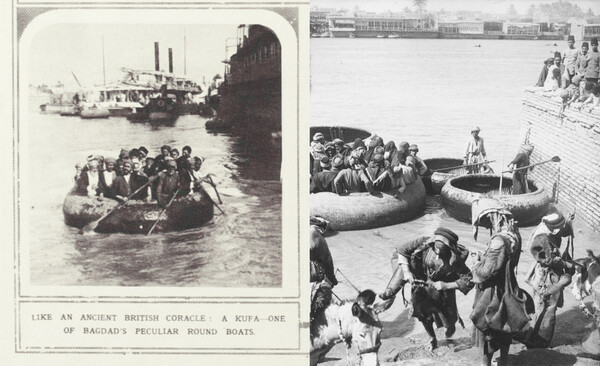The Great Diary Project
***
μία ιδέα του Irving Finkel
'Εχοντας ήδη στο ενεργητικό του ένα πιστό αντίγραφο μιας σουμεριανής "Κιβωτού" που κατασκευάστηκε με βάση ένα αρχαίο κείμενο, ο άγγλος αρχαιολόγος και ασσυριολόγος Irving Finkel, ένας από τους καλύτερους γνώστες του πολιτισμού της Μεσοποταμίας, προχώρησε σε ένα ακόμη πρωτότυπο εγχείρημα, τη συλλογή προσωπικών ημερολογίων.

Μία από τις 130.000 ταμπλέτες με σφηνοειδή γραφή που διαθέτει το Βρετανικό Μουσείο (η μεγαλύτερη υπάρχουσα συλλογή) προκάλεσε τυχαία το ενδιαφέρον του Irving Finkel. Η αποκρυπτογράφηση αυτής της άσημης εκ πρώτης όψης ταμπλέτας αργίλου αποκάλυψε, μέσα από μια αναφορά στο Έπος του Γκιλγκαμές, ένα λεπτομερή κατασκευαστικό οδηγό για μια κιβωτό που φέρεται να χρησιμοποιήθηκε στο Μεγάλο Κατακλυσμό. Η κιβωτός, σύμφωνα με την περιγραφή, είχε διάμετρο 67 μέτρα, διέθετε χωρίσματα για να δέχεται διάφορα είδη ζώων, και θύμιζε μεγάλο κοφίνι, όμοιο με τις "qufa", ή "coracles", που έπλεαν στο Νείλο και στον Τίγρη ποταμό από το 1.750 π.Χ ως και τη δεκαετία του '30 του περασμένου αιώνα. Στηριζόμενος στην περιγραφή αυτή, ο Irving Finkel προχώρησε στην κατασκευή ενός αντίγραφου αυτής της κιβωτού με τη βοήθεια μιας ομάδας Ινδών τεχνιτών που κατείχαν την απαραίτητη παραδοσιακή τεχνογνωσία.
Ο Irving Finkel πιστεύει πως η βαβυλωνιακή κιβωτός ήταν "το ιδανικό σκάφος για να σωθεί η ανθρωπότητα από τον τρομερό αυτόν Κατακλυσμό. Επρόκειτο για ένα τεράστιο εύκαμπτο κοφίνι που δεν μπορούσε να βυθιστεί. 'Επλεε ακολουθώντας τα ρεύματα, χωρίς να φέρνει σε κίνδυνο τους επιβάτες του -άντρες, γυναίκες και ζώα όλων των ειδών-, μέχρι να σταματήσουν οι βροχές, και να ηρεμήσουν ή να υποχωρήσουν τα νερά. Υπήρξε σαφέστατα ένας Κατακλυσμός και μία Κιβωτός στην πολύ μακρινή μεσοποταμιακή περίοδο." Προσθέτει πως το πιο παράξενο είναι πως αυτή η ταμπλέτα περιγράφει λεπτομερώς τα ζώα που επιβιβάζονταν στην Κιβωτό, καθώς και τον τρόπο -σε ζευγάρια- που αναπαράγουν οι πολύ μεταγενέστερες βιβλικές Γραφές.





The Great Diary Project
Diaries are among our most precious items of heritage. People in all walks of life have confided and often still confide their thoughts and experiences to the written page, and the result is a unique record of what happens to an individual over months, or even years, as seen through their eyes. No other kind of document offers such a wealth of information about daily life and the ups and downs of human existence. The Project's idea is to collect as many diaries as possible from now on for long-term preservation. In the future these diaries will be a precious indication of what life, in our own time, was really like.
What we can learn from diaries
The most remarkable details get recorded in diaries. The weather, movement of birds, the price of food, the regularity of the postal service and a hundred other matters ignored in the history books. Some people comment extensively on the politics around them, others take no notice of such things at all. Among all these come the excitement of children and holidays and remarks on religion, illness, death. All human life, in fact, is there, packed into small pages where every entry – for the future historian – is accurately dated. And what might seem today to be mundane and unimportant will, before long, take on quite a different significance. Imagine if we had hundreds and hundreds of diaries from people in Shakespeare's time today!

Diaries at Risk
Old diaries are at risk. Life-long diary-keepers frequently make no provision for what should happen to their diaries long term, and people who inherit them often dispose of them unthinkingly. Sometimes diaries are dusty, with resident spiders; sometimes they are in difficult handwriting or take up a lot of room. Diaries are also supposed to be private, and people often feel it is their duty to destroy them and keep them from prying eyes. The work of the Great Diary Project is to rescue diaries like these from skips and bonfires and look after them for the future as important items of everyone's history. Anyone who has old or unwanted diaries can be sure that Bishopsgate Institute will take them gratefully and look after them.
Rescuing diaries
The Great Diary Project has been set up to provide a permanent home for unwanted diaries of any date or kind. As we are primarily concerned with ensuring the survival of as many documents as possible, we adopt a very liberal interpretation of the word 'diary'. We are always happy to answer enquiries and we very seldom say no. For more information click here. The collection now contains over 2000 diaries, and is adding to this resource as extensively as possible. Once part of the collection, all diaries are housed according to up-to-date conservation standards. All diaries will be catalogued for the Project database, the contents of which will be made freely available to researchers and interested readers, who can consult the originals in Bishopsgate Institute reading room.
Privacy
Most people regard their diary as very private. Often they write about people and events in the certainty that no-one else will ever read their words. With the passage of time, however, this factor diminishes, and the moment comes when no-one any longer could be affected by the contents of someone else's diary. It is then that a manuscript diary passes from being just a personal record and becomes a testimony of far wider significance. Once a diary is no longer 'contemporary' its message can have value and interest for many other readers who come after. From this perspective a private diary becomes an important historical source. The Project will provide diaries within the collection permanent archival care. Please click here for more information.
thegreatdiaryproject.co.uk



























